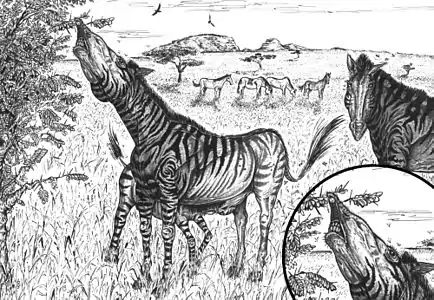Amerhippus
Amerhippus is an extinct subgenus of Equus which includes several species of horses that lived in South America. They were one of two groups of equines in South America alongside Hippidion.[2] Fossils have been recovered from the Tarija Formation of Bolivia, the Serranía del Perijá in Venezuela, the Chiu-Chiu Formation of Chile, the Sabana Formation of the Bogotá savanna in Colombia,[3] and from various locations in Ecuador.[4] The subgenus lived from 2.588 to 0.012 Mya. It measured roughly 1.5 m (4.9 ft) tall and weighed approximately 400 kg (880 lb). While they have formerly been referred to as belonging to 5 separate species, this has been revised down into three,[5] and more recently a single, morphologically variable species Equus neogeus.[6][7] Equus first appeared in South America during the late Early Pleistocene around 1 Ma.[2] A 2008 study of mitochondrial DNA fragments of a specimen of E. neogeus found it to be nested within mitochondrial lineages of E. caballus.[8] A close relationship to caballine horses was also supported by a 2019 morphological analysis study.[9]
| Amerhippus | |
|---|---|
 | |
| Skull of Amerhippus sp. | |
| Scientific classification | |
| Kingdom: | Animalia |
| Phylum: | Chordata |
| Class: | Mammalia |
| Order: | Perissodactyla |
| Family: | Equidae |
| Genus: | Equus |
| Subgenus: | †Amerhippus Hoffstetter, 1950 |
| Type species | |
| †Equus andium Branco, 1883 | |
| Species | |
| |
Gallery
.jpg.webp) Statue in Osorno, Chile
Statue in Osorno, Chile Restoration of hippidiforms with grazing Amerhippus in the background
Restoration of hippidiforms with grazing Amerhippus in the background
References
- "Amerhippus". NCBI taxonomy. Bethesda, MD: National Center for Biotechnology Information. Retrieved 17 January 2019.
- PRADO, JOSE LUIS; ALBERDI, MARIA TERESA (2018). FOSSIL HORSES OF SOUTH AMERICA : phylogeny, systemics and ecology. SPRINGER INTERNATIONAL PU. doi:10.1007/978-3-319-55877-6. ISBN 3-319-85769-X. OCLC 1048948248.
- De Porta, Jaime. 1960. Los Equidos fósiles de la Sabana de Bogotá. Boletín de Geología, Universidad Industrial de Santander 4. 51–78. Accessed 2017-03-30.
- Prado, J. L.; Alberdi, M. A. T.; De Reyes, M. N. L.; Poiré, D. G.; Canalicchio, J. M. (2013). "New material of Equus (Amerhippus) neogeus (Mammalia, Perissodactyla) from the late Pleistocene of Olavarría (Argentina)". Neues Jahrbuch für Geologie und Paläontologie - Abhandlungen. 269 (2): 125. doi:10.1127/0077-7749/2013/0340. hdl:10261/115119.
- Prado, J. L., and Alberdi, M. T. (2017). Fossil Horses of South America. Springer International Publishing, 150
- Machado, Helena; Grillo, Orlando; Scott, Eric; Avilla, Leonardo (September 2018). "Following the Footsteps of the South American Equus: Are Autopodia Taxonomically Informative?". Journal of Mammalian Evolution. 25 (3): 397–405. doi:10.1007/s10914-017-9389-6. ISSN 1064-7554.
- Machado, Helena; Avilla, Leonardo (2019-07-03). "The Diversity of South American Equus: Did Size Really Matter?". Frontiers in Ecology and Evolution. 7: 235. doi:10.3389/fevo.2019.00235. ISSN 2296-701X.
- Orlando, Ludovic; Male, Dean; Alberdi, Maria Teresa; Prado, Jose Luis; Prieto, Alfredo; Cooper, Alan; Hänni, Catherine (May 2008). "Ancient DNA Clarifies the Evolutionary History of American Late Pleistocene Equids". Journal of Molecular Evolution. 66 (5): 533–538. doi:10.1007/s00239-008-9100-x. ISSN 0022-2844.
- Barrón-Ortiz, Christina I.; Avilla, Leonardo S.; Jass, Christopher N.; Bravo-Cuevas, Víctor M.; Machado, Helena; Mothé, Dimila (2019-09-12). "What Is Equus? Reconciling Taxonomy and Phylogenetic Analyses". Frontiers in Ecology and Evolution. 7: 343. doi:10.3389/fevo.2019.00343. ISSN 2296-701X.
